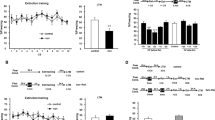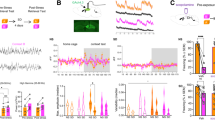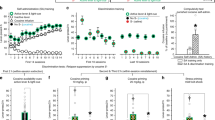Abstract
As an extension of our recent experiments on transfer of morphine tolerance1, we tried to explore the possibility of a similar transfer of the tolerance which develops to repeated physical stimuli. Such tolerance, called habituation, is defined as the loss of an innate response to a stimulus repeated without reinforcement2. It is considered to be one of the most elementary forms of learning.
This is a preview of subscription content, access via your institution
Access options
Subscribe to this journal
Receive 51 print issues and online access
$199.00 per year
only $3.90 per issue
Buy this article
- Purchase on Springer Link
- Instant access to full article PDF
Prices may be subject to local taxes which are calculated during checkout
Similar content being viewed by others
References
Ungar, G., Fed. Proc., 24, 548 (1965).
Thorpe, W. H., Learning and Instinct in Animals (Harvard Univ. Press, Cambridge, Mass., 1958).
Prosser, C. L., and Hunter, W. S., Amer. J. Physiol., 117, 609 (1936).
Glaser, E. M., and Griffin, J. P., J. Physiol., 160, 429 (1962).
Westerman, R. A., Science, 140, 676 (1963).
Hyden, H., and Egyhazy, E., Proc. U.S. Nat. Acad. Sci., 48, 1366 (1962).
Author information
Authors and Affiliations
Rights and permissions
About this article
Cite this article
UNGAR, G., OCEGUERA-NAVARRO, C. Transfer of Habituation by Material extracted from Brain. Nature 207, 301–302 (1965). https://doi.org/10.1038/207301a0
Issue Date:
DOI: https://doi.org/10.1038/207301a0
This article is cited by
-
What history tells us VI. The transfer of behaviours by macromolecules
Journal of Biosciences (2006)
-
Postural changes in healthy rats after intracranial injection of brain extracts from animals with experimental vestibulopathy
Bulletin of Experimental Biology and Medicine (1981)
-
The synthesis of a peptide having the structure attributed to a sound habituating material
Experientia (1975)
-
Induction (transfer) of an operant behaviour by injection of brain extract
Psychopharmacologia (1973)
-
Molecular coding of information in the nervous system
Die Naturwissenschaften (1972)
Comments
By submitting a comment you agree to abide by our Terms and Community Guidelines. If you find something abusive or that does not comply with our terms or guidelines please flag it as inappropriate.



